问答
发起
提问
文章
攻防
活动
Toggle navigation
首页
(current)
问答
商城
实战攻防技术
漏洞分析与复现
NEW
活动
摸鱼办
搜索
登录
注册
基于yii框架的系统审计
漏洞分析
某次审计基于YII框架二开的系统
基于yii框架的系统审计 ============ 前言 -- 某次审计基于YII框架二开的系统 YII框架基础 ------- ### Yii控制器 #### 创建控制器 在yii\\web\\Application网页应用中,控制器应继承yii\\web\\Controller 或它的子类。 同理在yii\\console\\Application控制台应用中,控制器继承yii\\console\\Controller 或它的子类。 如下代码定义一个 `site` 控制器: ```php namespace app\controllers; use yii\web\Controller; class SiteController extends Controller { } ``` #### 控制器ID 通常情况下,控制器用来处理请求有关的资源类型,因此控制器ID通常为和资源有关的名词。 例如使用`article`作为处理文章的控制器ID。 控制器ID应仅包含英文小写字母、数字、下划线、中横杠和正斜杠, 例如 `article` 和 `post-comment` 是真是的控制器ID,`article?`, `PostComment`, `admin\post`不是控制器ID。 控制器Id可包含子目录前缀,例如 `admin/article` 代表 yii\\base\\Application::controllerNamespace控制器命名空间下 `admin`子目录中 `article` 控制器。 子目录前缀可为英文大小写字母、数字、下划线、正斜杠,其中正斜杠用来区分多级子目录(如`panels/admin`)。 #### 控制器类命名 控制器ID遵循以下规则衍生控制器类名: - 将用正斜杠区分的每个单词第一个字母转为大写。注意如果控制器ID包含正斜杠,只将最后的正斜杠后的部分第一个字母转为大写; - 去掉中横杠,将正斜杠替换为反斜杠; - 增加`Controller`后缀; - 在前面增加yii\\base\\Application::controllerNamespace控制器命名空间. 下面为一些示例,假设yii\\base\\Application::controllerNamespace控制器命名空间为 `app\controllers`: - `article` 对应 `app\controllers\ArticleController`; - `post-comment` 对应 `app\controllers\PostCommentController`; - `admin/post-comment` 对应 `app\controllers\admin\PostCommentController`; - `adminPanels/post-comment` 对应 `app\controllers\adminPanels\PostCommentController` ### 路由 终端用户通过所谓的*路由*寻找到操作,路由是包含以下部分的字符串: - 模型ID: 仅存在于控制器属于非应用的模块; - 控制器ID: 同应用(或同模块如果为模块下的控制器)下唯一标识控制器的字符串; - 操作ID: 同控制器下唯一标识操作的字符串。 路由使用如下格式: ```php ControllerID/ActionID ``` 如果属于模块下的控制器,使用如下格式: ```php ModuleID/ControllerID/ActionID ``` 如果用户的请求地址为 `http://hostname/index.php?r=site/index`, 会执行`site` 控制器的`index` 操作。 ### 自实现路由 在本系统中,除了controller目录下创建控制器外,还有在plugins目录中也存在。并且在`core/application.php`中通过重写`runAction`方法使之可运行插件`plugins`下的代码 具体实现如下: ```php public function runAction($route, $params = []) { bcscale(2);//配置BC函数小数精度 $route = ltrim($route, '/'); $pattern = '/^plugin\/.*/'; preg_match($pattern, $route, $matches); if ($matches) { $originRoute = $matches[0]; $originRouteArray = mb_split('/', $originRoute); $pluginId = !empty($originRouteArray[1]) ? $originRouteArray[1] : null; if (!$pluginId) { throw new NotFoundHttpException(); } if (!$this->plugin->getInstalledPlugin($pluginId)) { throw new NotFoundHttpException(); } $controllerId = 'index'; $controllerClass = "app\\plugins\\{$pluginId}\\controllers\\IndexController"; $actionId = 'index'; $appendNamespace = ''; for ($i = 2; $i < count($originRouteArray); $i++) { $controllerId = !empty($originRouteArray[$i]) ? $originRouteArray[$i] : 'index'; $controllerName = preg_replace_callback('/\-./', function ($e) { return ucfirst(trim($e[0], '-')); }, $controllerId); $controllerName = ucfirst($controllerName); $controllerName .= 'Controller'; $controllerClass = "app\\plugins\\{$pluginId}\\controllers\\{$appendNamespace}{$controllerName}"; $actionId = !empty($originRouteArray[$i + 1]) ? $originRouteArray[$i + 1] : 'index'; if (class_exists($controllerClass)) { break; } $appendNamespace .= $originRouteArray[$i] . '\\'; } try { /** @var Controller $controller */ $controller = \Yii::createObject($controllerClass, [$controllerId, $this]); $module = new Module($pluginId, $this); $controller->module = $module; $this->controller = $controller; \Yii::$app->plugin->setCurrentPlugin(\Yii::$app->plugin->getPlugin($pluginId)); return $controller->runAction($actionId, $params); } catch (\ReflectionException $e) { throw new NotFoundHttpException(\Yii::t('yii', 'Page not found.'), 0, $e); } } return parent::runAction($route, $params); } ``` 主要处理逻辑是 1. 首先匹配$route中是否以`/plugin/`开头 2. 将$route以`/`进行分割定位具体的controllerID和ActionID 3. 调用$controller->runAction()来执行该控制器文件的文件的$actionId -> action方法 比如请求URL如下 ```php index.php?r=plugin/booking/api/index/index -> web/app/plugins/booking/contorllers/api/IndexController.php::actionIndex() ``` 难点解决 ---- 我们发现在此系统中有上千个controller.php文件,要是一个个审计其工作量是巨大。在控制器多而杂的情况下,想要快速的过一遍然后找到没有鉴权的方法/控制器进行快速审计,我们可以根据URI对应控制器的特征: ```php index.php?r=plugin/booking/api/index/index -> web/app/plugins/booking/contorllers/api/IndexController.php::actionIndex() index.php?r=admin/api/v1/user/get-user -> /web/app/Api/Controllers/v1/UserController.php::actionGetUser() ``` 这里特征就很明显了:以`"/"`对参数r的值进行分割的话,`/web/app/`下的文件夹构成了第一部分,而在对应文件夹下的`controllers目录`下的文件夹及`xxController.php`文件名前半部分(即此处的xx)构成了第二、三...部分,最后一部分是由公开方法名`(去除Action)`构成。 并且我们知道无论是文件夹还是文件的名字都要变成小写,且有两个及以上连续的单词构建的文件夹、文件、方法都需要转为小写,且使用"-"符号来连接。 基于如上结果,在Mac下,我首先会通过如下命令,将所有的控制器文件路径获取,保存在url.txt中: ```bash tree -f -i | grep "Controller.php" > url.txt ``` Windowx下使用如下命令(来自ChatGPT): ```bash tree /f /a | findstr /i "Controller.php" > url.txt ``` 接着写了一个简单的Python脚本遵循控制器对应URI的逻辑 ```python import os import re def getFileNamePath(path): controlFilePath = [] files = os.listdir(path) # 获取当前目录的所有文件及文件夹 for file in files: try: file_path = os.path.join(path, file) # 获取绝对路径 if os.path.isdir(file_path): # 判断是否是文件夹 getFileNamePath(file_path) # 如果是文件夹,就递归调用自己 else: if 'Controller' in os.path.splitext(file_path)[0]: # 查找后缀为.md的文件 cur_path = os.path.dirname(os.path.realpath(file_path)) # 查找文件的绝对路径 controlFilePath.append((cur_path + '\\' + file)) except: continue # 可能会报错,所以用了try-except,如果要求比较严格,不需要报错,就删除异常处理,自己调试 with open("./url.txt", "a+") as k: for y in controlFilePath: k.write(y + "\n") def getUri(): pattern = r"public function action(.*?)\(\)" with open("./url.txt") as f: for i in f.readlines(): x = i.replace("\n", "").replace("\\", "/") with open(x, encoding='gb18030', errors='ignore') as v: matches = re.findall(pattern, v.read()) for c in matches: c = "-".join(re.findall('[A-Za-z][a-z]*', c)).lower() y = x.replace("/controllers", "").replace("Controller.php", "") + "/" + c if "plugin" not in y: y = y.lower() print(y) with open("./res.txt", "a+") as k: k.write(y + "\n") if __name__ == '__main__': path = "" getFileNamePath(path) getUri() ``` 处理路径、提取公开方法、拼接,形成一个字典res.txt 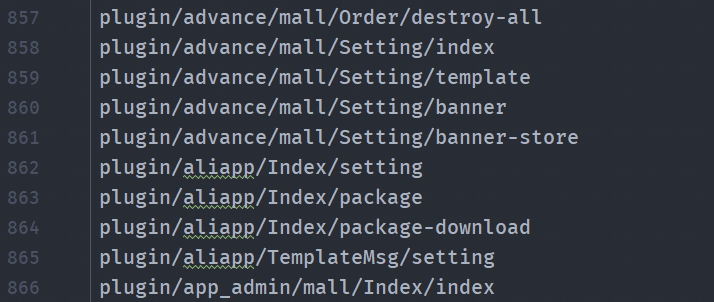 再代入到参数r中进行枚举,结合HaE的特征匹配  ### 漏洞发现 发现了一些mysql报错信息 在三个`Goods`相关的请求中都是报错提示数据表缺少列名  在具体的模型中,可传入page,type和cat\_id三个参数 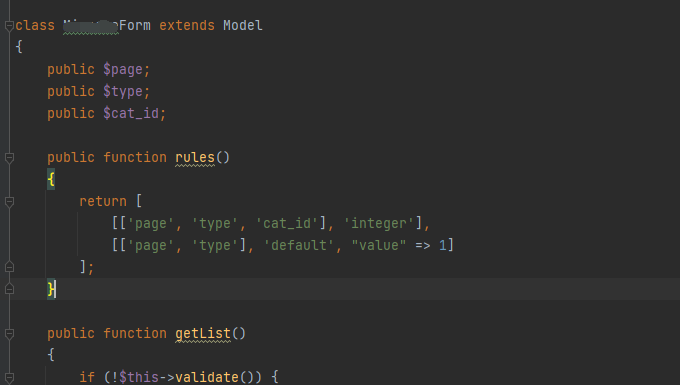 而且rules中规定了三个都是interger类似,无法注入 最后的希望来到了booking相关的请求  结合白盒对特定controller进行审计,根据路由特征找到响应的controller,这里路由为`plugin/xxx/api/Booking/store-list`对应`plugins/xxx/controllers/api`目录下的`BookingController.php`中的`actionStoreList()`方法  首先创建了`BookingForm`类,利用`\Yii::$app->request->get()`获取get请求中的参数赋值给`$form->attributes`变量 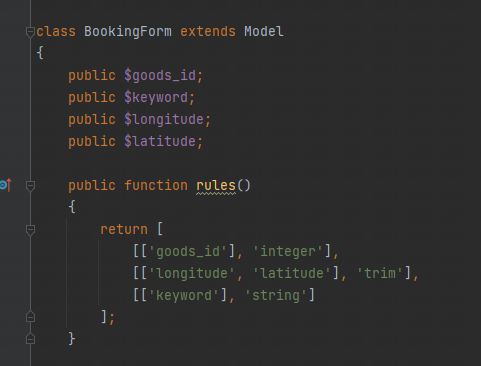  可以看到`BookingForm`类是继承自`\yii\base\Model`类 > 模型是 [MVC](http://en.wikipedia.org/wiki/Model%E2%80%93view%E2%80%93controller) 模式中的一部分, 是代表业务数据、规则和逻辑的对象。 > > 可通过继承 yii\\base\\Model 或它的子类定义模型类,基类yii\\base\\Model支持许多实用的特性: > > - [属性](http://www.yiichina.com/doc/guide/2.0/structure-models#attributes): 代表可像普通类属性或数组一样被访问的业务数据; > - [属性标签](http://www.yiichina.com/doc/guide/2.0/structure-models#attribute-labels): 指定属性显示出来的标签; > - [块赋值](http://www.yiichina.com/doc/guide/2.0/structure-models#massive-assignment): 支持一步给许多属性赋值; > - [验证规则](http://www.yiichina.com/doc/guide/2.0/structure-models#validation-rules): 确保输入数据符合所申明的验证规则; > - [数据导出](http://www.yiichina.com/doc/guide/2.0/structure-models#data-exporting): 允许模型数据导出为自定义格式的数组。 默认情况下模型类直接从yii\\base\\Model继承,所有 *non-static public非静态公有* 成员变量都是属性。`BookingForm`模型类有四个属性`$goods_id`, `$keyword`, `$longitude` and `$latitude`, `BookingForm` 模型用来代表从HTML表单获取的输入数据。 同时定义了属性输入验证: ```php public function rules() { return [ [['goods_id'], 'integer'], [['longitude', 'latitude'], 'trim'], [['keyword'], 'string'] ]; } ``` 其中`goods_id`和`keyword`变量规定类型为整数和字符串,`longitude`和`latitude`变量会去除前后空格即执行trim()函数 在`BookingController.php`中的`actionStoreList()`方法中利用块赋值对`BookingForm`模型类进行赋值 ```php $form->attributes = \Yii::$app->request->get(); ``` 即我们构造请求 ```http GET /web/index.php?r=plugin/xxx/api/Booking/store-list&longitude=1&latitude=1&keyword=1&goods_id=1 HTTP/1.1 ``` 即可完成对`BookingForm`模型类属性赋值 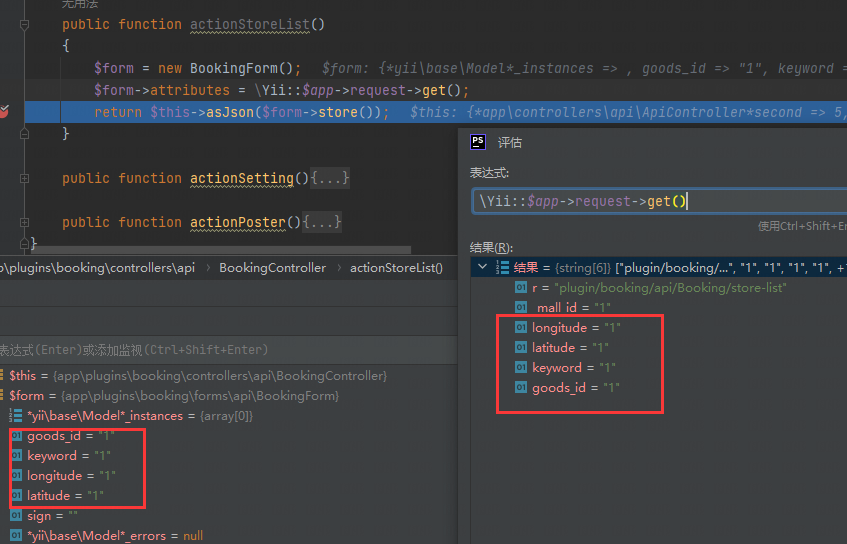 随后调用`BookingForm::store()`方法,我们跟进到`BookingForm::store()`: ```php public function store() { try { if (!$this->validate()) { return $this->getErrorResponse(); } $store = BookingStore::find()->alias('b')->where([ 'b.mall_id' => \Yii::$app->mall->id, 'b.goods_id' => $this->goods_id, 'b.is_delete' => 0, 's.is_delete' => 0, ])->joinWith(['store s']) ->select(['*', "(st_distance(point(longitude, latitude), point($this->longitude, $this->latitude)) * 111195) as distance"]) ->keyword($this->keyword, ['like', 's.name', $this->keyword]) ->page($pagination) ->orderBy('distance ASC') ->asArray() ->all(); $store = array_map(function ($item) { $info = $item['store']; if ($info['longitude'] && $info['latitude'] && $this->longitude && $this->latitude) { $distance = get_distance($item['store']['longitude'], $item['store']['latitude'], $this->longitude, $this->latitude); if ($distance > 1000) { $info['distance'] = number_format($distance / 1000, 2) . 'km'; } else { $info['distance'] = number_format($distance, 0) . 'm'; } } else { $info['distance'] = '-m'; } return $info; }, $store); return [ 'code' => ApiCode::CODE_SUCCESS, 'data' => [ 'list' => $store, ] ]; } catch (\Exception $e) { return [ 'code' => ApiCode::CODE_ERROR, 'msg' => $e->getMessage(), ]; } } ``` 这里`BookingStore`类继承自`\yii\db\ActiveRecord`,在Yii框架中主要是进行sql查询,其类名`BookingStore`表示数据库中的`booking_store`表 > [Active Record](https://zh.wikipedia.org/wiki/%E4%B8%BB%E5%8A%A8%E8%AE%B0%E5%BD%95) 提供了一个面向对象的接口, 用以访问和操作数据库中的数据。Active Record 类与数据库表关联, Active Record 实例对应于该表的一行, Active Record 实例的*属性*表示该行中特定列的值。 您可以访问 Active Record 属性并调用 Active Record 方法来访问和操作存储在数据库表中的数据, 而不用编写原始 SQL 语句。 在代码中可以看到首先是根据模型属性构造sql查询,并将结果进行遍历赋值给给新的`$store`,最后输出返回response  根据定义的属性输入验证,`$keyword`, `$longitude` and `$latitude`可以是字符串类型,极有可以存在注入,根据查询方法: ```php ->select(['*', "(st_distance(point(longitude, latitude), point($this->longitude, $this->latitude)) * 111195) as distance"]) ->keyword($this->keyword, ['like', 's.name', $this->keyword]) ``` `$longitude` and `$latitude`是在select方法中,`$keyword`在keyword方法中,而keyword()方法其实是实现了`\yii\db\Query::andWhere`方法: ```php public function keyword($keyword, $condition) { if ($keyword) { $this->andWhere($condition); } return $this; } ``` 在yii中属于附件条件 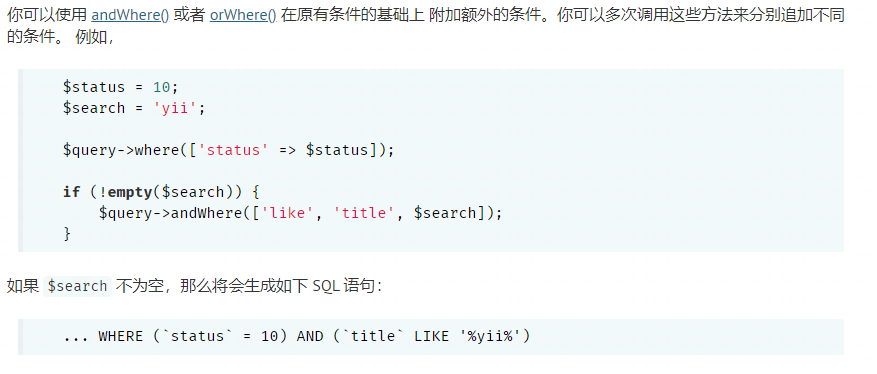 其应该是形成 ```sql AND (`s.name` LIKE '%$keyword%') ``` 当我们构造`keyword=%'''%`,按理应该会闭合模糊查询的%',即 ```sql AND (`s.name` LIKE '%%'''%%') ``` 因为'单引号溢出而报错,但是请求却是正常的  而我们对`longitude` 和`latitude`进行单引号测试,发现成功报错 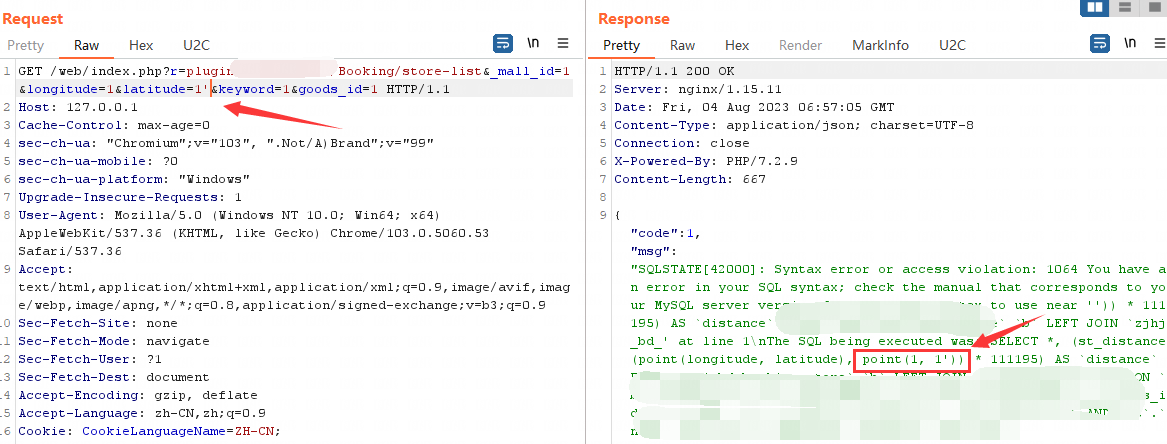 利用报错语法成功注入  那么问题来了,为什么select()方法可以,而andWhere()方法却不可以 原来在构造查询语句时以占位符的方式创建预处理语句,即 ```php AND (`s.name` LIKE :keyword, $keyword) ``` 但在`buildSelect()`方法中传入的参数直接拼接,即: ```php select(['*', "(st_distance(point(longitude, latitude), point($this->longitude, $this->latitude)) * 111195) as distance"]) => SELECT *,(st_distance(point(longitude, latitude), point($this->longitude, $this->latitude)) * 111195) as distance ``` 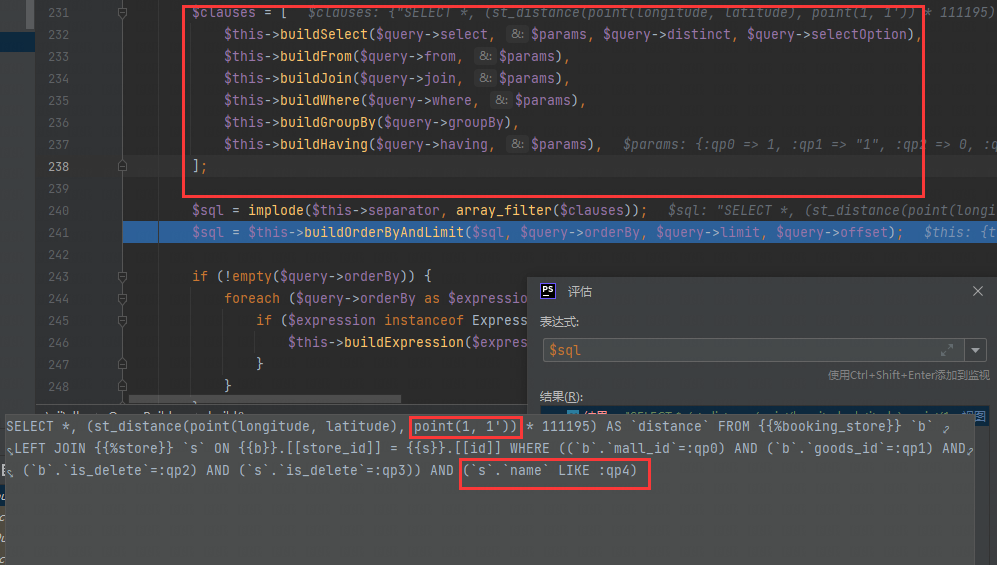 后续在进行参数绑定,执行`bindParam`是会对`$keyword`参数中特殊字符做转义,导致无法逃逸  在select操作中,传入的变量$this->longitude和$this->latitude直接作为字符串传入到select() ,最终导致$this->longitude和$this->latitude存在SQL注入 ### 总结 做PHP审计的时候经常会遇到MVC框架的程序,在控制器多而杂的情况下,想要快速的过一遍然后找到没有鉴权的方法/控制器进行快速审计,我们可以根据URI对应控制器的特征,利用脚本构造出所有的接口url,进行批量遍历找到可能存在漏洞的未授权接口,实现快速审计。
发表于 2023-08-24 09:00:01
阅读 ( 11368 )
分类:
漏洞分析
3 推荐
收藏
0 条评论
请先
登录
后评论
中铁13层打工人
86 篇文章
×
发送私信
请先
登录
后发送私信
×
举报此文章
垃圾广告信息:
广告、推广、测试等内容
违规内容:
色情、暴力、血腥、敏感信息等内容
不友善内容:
人身攻击、挑衅辱骂、恶意行为
其他原因:
请补充说明
举报原因:
×
如果觉得我的文章对您有用,请随意打赏。你的支持将鼓励我继续创作!